RBM8A, a new target of TEAD4, promotes breast cancer progression by regulating IGF1R and IRS-2
- PMID: 39232805
- PMCID: PMC11373126
- DOI: 10.1186/s12967-024-05639-0
RBM8A, a new target of TEAD4, promotes breast cancer progression by regulating IGF1R and IRS-2
Abstract
Background: Breast cancer (BC) is the most common malignant tumor in women worldwide, and further elucidation of the molecular mechanisms involved in BC pathogenesis is essential to improve the prognosis of BC patients. RNA Binding Motif Protein 8 A (RBM8A), with high affinity to a myriad of RNA transcripts, has been shown to play a crucial role in genesis and progression of multiple cancers. We attempted to explore its functional significance and molecular mechanisms in BC.
Methods: Bioinformatics analysis was performed on publicly available BC datasets. qRT-PCR was used to determine the expression of RBM8A in BC tissues. MTT assay, clone formation assay and flow cytometry were employed to examine BC cell proliferation and apoptosis in vitro. RNA immunoprecipitation (RIP) and RIP-seq were used to investigate the binding of RBM8A/EIF4A3 to the mRNA of IGF1R/IRS-2. RBM8A and EIF4A3 interactions were determined by co-immunoprecipitation (Co-IP) and immunofluorescence. Chromatin immunoprecipitation (Ch-IP) and dual-luciferase reporter assay were carried out to investigate the transcriptional regulation of RBM8A by TEAD4. Xenograft model was used to explore the effects of RBM8A and TEAD4 on BC cell growth in vivo.
Results: In this study, we showed that RBM8A is abnormally highly expressed in BC and knockdown of RBM8A inhibits BC cell proliferation and induces apoptosis in vitro. EIF4A3, which phenocopy RBM8A in BC, forms a complex with RBM8A in BC. Moreover, EIF4A3 and RBM8A complex regulate the expression of IGF1R and IRS-2 to activate the PI3K/AKT signaling pathway, thereby promoting BC progression. In addition, we identified TEAD4 as a transcriptional activator of RBM8A by Ch-IP, dual luciferase reporter gene and a series of functional rescue assays. Furthermore, we demonstrated the in vivo pro-carcinogenic effects of TEAD4 and RBM8A by xenograft tumor experiments in nude mice.
Conclusion: Collectively, these findings suggest that TEAD4 novel transcriptional target RBM8A interacts with EIF4A3 to increase IGF1R and IRS-2 expression and activate PI3K/AKT signaling pathway, thereby further promoting the malignant phenotype of BC cells.
Keywords: Breast cancer; EIF4A3; PI3K/AKT; RBM8A; TEAD4.
© 2024. The Author(s).
Conflict of interest statement
The authors declare no competing interests.
Figures

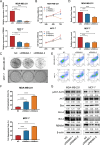
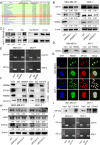
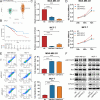
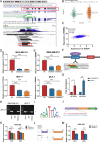
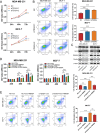
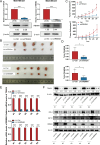

Similar articles
-
CircMYH9 promotes the mRNA stability of SPAG6 by recruiting EIF4A3 to facilitate the progression of breast cancer.Epigenetics. 2025 Dec;20(1):2482382. doi: 10.1080/15592294.2025.2482382. Epub 2025 Mar 27. Epigenetics. 2025. PMID: 40145872 Free PMC article.
-
Curcumin alleviates the aggressiveness of breast cancer through inhibiting cell adhesion mediated by TEAD4-fibronectin axis.Biochem Pharmacol. 2025 Feb;232:116690. doi: 10.1016/j.bcp.2024.116690. Epub 2024 Nov 29. Biochem Pharmacol. 2025. PMID: 39617209
-
TEAD4 modulated LncRNA MNX1-AS1 contributes to gastric cancer progression partly through suppressing BTG2 and activating BCL2.Mol Cancer. 2020 Jan 10;19(1):6. doi: 10.1186/s12943-019-1104-1. Mol Cancer. 2020. PMID: 31924214 Free PMC article.
-
Vestigial-like family member 1 (VGLL1): An emerging candidate in tumor progression.Biochem Biophys Res Commun. 2025 Jun 20;766:151889. doi: 10.1016/j.bbrc.2025.151889. Epub 2025 Apr 24. Biochem Biophys Res Commun. 2025. PMID: 40300335 Review.
-
Purine-rich element binding protein alpha: a DNA/RNA binding protein with multiple roles in cancers.Mol Med. 2025 Jan 22;31(1):20. doi: 10.1186/s10020-025-01087-8. Mol Med. 2025. PMID: 39844051 Free PMC article. Review.
Cited by
-
RBM8A promotes gastric cancer progression by binding with UPF3B to induce BBC3 mRNA degradation.Int J Mol Med. 2025 Sep;56(3):131. doi: 10.3892/ijmm.2025.5572. Epub 2025 Jul 4. Int J Mol Med. 2025. PMID: 40613240 Free PMC article.
-
Integrating single-cell regulatory atlas and multi-omics data for differential treatment response and multimodal predictive modeling in CDK 4/6 inhibitor-treated breast cancer.Front Oncol. 2025 Jul 17;15:1585574. doi: 10.3389/fonc.2025.1585574. eCollection 2025. Front Oncol. 2025. PMID: 40746611 Free PMC article.
References
MeSH terms
Substances
Grants and funding
LinkOut - more resources
Full Text Sources
Medical
Molecular Biology Databases
Miscellaneous

